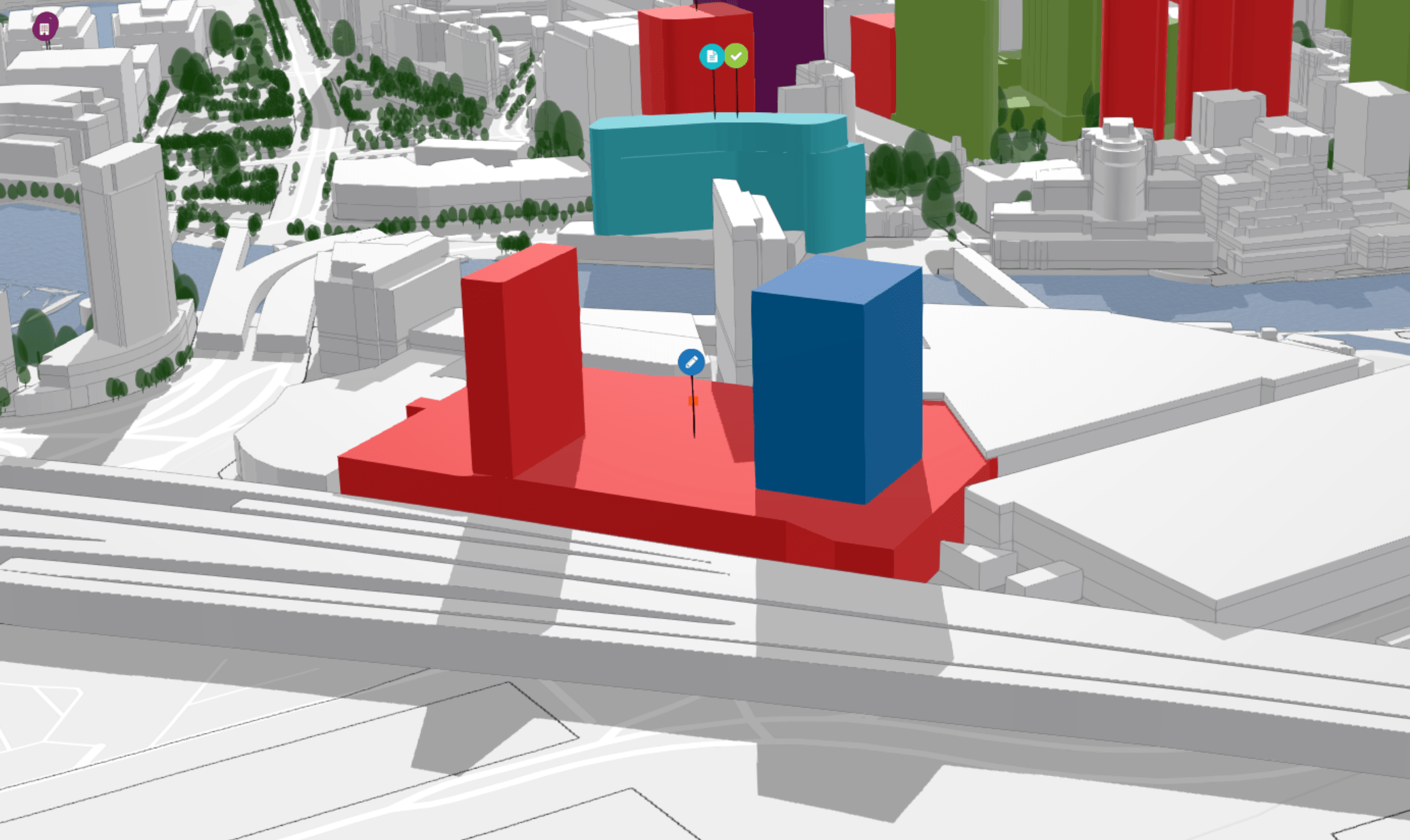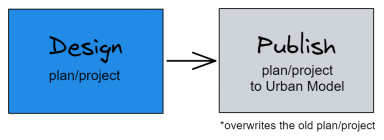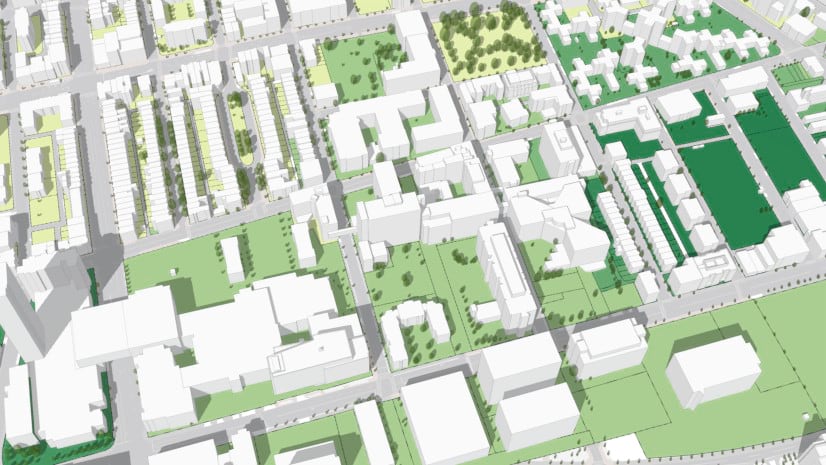In the February 2022 release of ArcGIS Urban, we have simplified and improved how cities can share plans and projects with stakeholders and the public. To sum it up: the publishing workflow was replaced with the sharing capabilities of ArcGIS Online. In this blog post we will explain how the improved sharing workflow in Urban compares to the previous publishing workflow.
Making urban design scenarios available to stakeholders or the public is a common workflow that we have supported since the first release in 2019. The previous versions of Urban supported this workflow by publishing a plan or a project with its scenarios to the Urban Model. As a next step, the Urban Model could then be shared with stakeholders or the public so they could access the published plans and projects.
Improved sharing workflow
One problem with the publishing workflow was that each public project or plan existed twice in two separate databases – in the urban design database (an ArcGIS Online item storing a single design plan or project) as well as in the urban database (an ArcGIS Online item storing all public plans and projects). This caused unnecessary duplication of data and led to a visual overlap in the overview, e.g., for public and design projects.

Additionally, the urban design database itself could also be shared with the public through the well-known ArcGIS Online sharing capabilities.
This duplication of functionality confused many users and was a source of bugs in the development of the application. That’s why we simplified this workflow for the February 2022 release to one single method. It is all called sharing from now on and only uses the ArcGIS Online sharing capabilities under the hood.
Publishing – old workflow
The previous version of Urban supported the following workflow to make projects or plans available to the public:

- Design a plan/project.
- Share the plan/project with a group or individual users for internal feedback.
- Publish the plan/project to the Urban Model (urban database).
- Share the Urban Model with everybody for public feedback.
To update the plan/project for the public you had to perform the following steps:

- Update the design plan/project.
- Publish the plan/project to the Urban Model.
This overwrites the previously published public plan/project.
Sharing – new workflow
In the new workflow, we have removed the publishing step. For the new workflow we use the sharing capabilities in ArcGIS Online – both for internal & external sharing.
So, to make projects or plans available to the public, you can simply use sharing now:

- Design a plan/project.
- Share the plan/project.
- For internal feedback with a group or individual users.
Editing can optionally be locked for others. - For public feedback with everybody.
Editing is only available for the owner.
- For internal feedback with a group or individual users.
- Share the Urban Model with everybody for public feedback.
And to update the plan/project for the public:

For smaller edits (and as an owner):
- Update the publicly shared design plan/project directly.
For larger re-designs:
- Share the plan/project to be available only for the owner or a group.
- Update the design plan/project.
- Share the plan/project again with everybody for public feedback.
Export – leverage the power of the ArcGIS platform
To best leverage the power of the whole ArcGIS platform, we highly recommend making use of the export functionality in Urban to facilitate public outreach & engagement for design plans.
Plan scenarios can be exported to web scenes and be used in SceneViewer for advanced styling and smart mapping, in ArcGIS StoryMaps for story telling, in Hub sites for comments and engagement, and in ArcGIS Dashboards for reporting.

The existing export to web scene capability in Urban comes with an aggregation step that creates a feature service with a flattened data structure, so it is easier to further process and visualize the data for presentations and reports.
If you are not making use of this workflow yet for your design plans, it is high time to check it out! We will also be working on improving the export functionalities in upcoming versions of Urban.
Frequently Asked Questions
We understand that this might feel like a big change, so we’ve put together answers to – what we believe must be – your most burning questions at this point. We hope these will allow you to better understand the implications for your setup of ArcGIS Urban.
Q: Can I still access and use existing public projects & plans?
Yes, all public projects & plans are still accessible in read-only mode the same way as before.
Q: What do you recommend doing with existing public projects & plans?
We recommend to continue any work on the original design plan/project. Once you adapt to the new workflow, you can simply remove the associated public plan/project. If a project only exists as a public project (e.g., it was directly imported through the data manager), you can save a copy of that project where you can continue editing.
Q: Can I still upload multiple public projects all at once?
Yes, this workflow is still supported and will remain as it is. You can use the projects tab in the data manager to upload multiple projects to your Urban Model that will then inherit the sharing options of the Urban Model. So, in case your Urban Model is shared with the public, the projects are shared with the public as well.
Q: How can I share only a subset of scenarios of a plan/project with stakeholders or the public?
If you want to share just one or a few scenarios of your plan/project, we recommend creating a copy of your plan/project and removing the scenarios you wish to hide.
Q: How can I share a version of Urban that contains all public plans and projects?
The overview of Urban will continue to display all publicly shared plans and projects when opened without signing in (e.g., by a citizen). As before, a citizen will be able to look at plans and projects and explore.
Q: How can I access all public plans and projects, e.g., to create a dashboard to track statuses?
With the new sharing workflow, you will no longer be able to automatically retrieve all public projects and plans from the urban database, for example to show a dashboard with all projects and their statuses.
However, this is just a temporary limitation. We are currently working on a future capability that will allow you to export all the projects in your Urban Model including more styling and customization. Stay tuned!
We hope this article helped you to understand the improved sharing workflow in Urban that replaces the publishing workflow. In case we didn’t answer your question – please reach out to us with further questions. We are always happy to help!


Article Discussion: